The Australian Synchrotron User Meeting in December 2011 attracted an enthusiastic crowd of over 230 synchrotron experts, users and prospective users.
In response to user feedback from the 2010 meeting, synchrotron users, through the User Advisory Committee (UAC), played key roles in setting the agenda, organising the event (ably assisted by the AS External Relations team) and developing the program for the meeting.
Held at the Lakeside Sebel in the Melbourne suburb of Albert Park, the 2011 User Meeting provided a fertile environment for participants to share their research experiences and plan future collaborations. Presentations by plenary speakers from Italy, New Zealand and Australia were complemented by 60 other speakers and more than 80 posters featuring synchrotron research projects.
The meeting commenced with a welcome from the Chair of the UAC, Richard Garrett. Richard was followed by AS Head of Science Andrew Peele and Director Keith Nugent, who provided an update on facility activities and developments over the last 12 months.
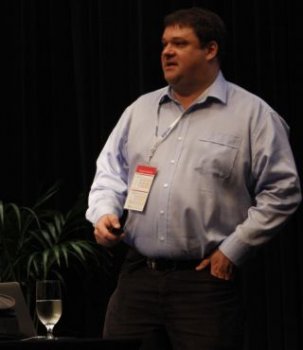
James Whisstock: mammalian immune systems
Plenary speaker James Whisstock from Monash University talked about an important group of proteins: the membrane attack complex / perforin (MACPF)-like protein superfamily. These proteins play a central role in mammalian immune systems, defending against attack from infectious organisms. Using the Australian Synchrotron (crystallography and small angle x-ray scattering) and other complementary techniques, James and his colleagues determined the atomic structures of a MACPF protein and perforin itself as well as the structure and mechanism of formation of the perforin pore. This new information yielded the surprising finding that the MACPF-like superfamily is structurally related to an ancient and lethal family of bacterial pore-forming toxins – and also revealed striking differences in how these molecules assemble to form pores. Taken together, the data suggest approaches to control unwanted MACPF activity in immune-driven diseases such as transplant rejection.
 Mike Lawrence: high-throughput crystallography
Mike Lawrence: high-throughput crystallography
Mike Lawrence from the Walter and Eliza Hall Institute discussed his latest research into the binding of insulin to its receptor and its significance in diabetes, cancer and Alzheimer’s disease. He noted that structural biologists lead the use of the AS in fundamental and translational research, and pointed out that half of all peer-reviewed AS publications arise from the MX / SAXS beamlines, demonstrating the community’s strength and the high operational standards of these beamlines. Mike went on to explain the potential value of developing a new undulator-based beamline (MX3D) at the Australian Synchrotron. This beamline would enable high-throughput tray screening and ultra-high-throughput single-crystal data collection as well standard MX use, rivalling the best such beamlines currently being built internationally.
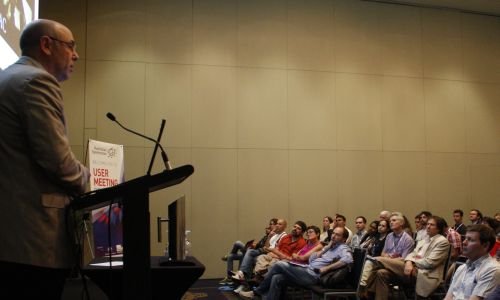 Simon Clark: earth sciences
Simon Clark: earth sciences
Simon Clark from the Advanced Light Source at the Lawrence Berkeley National Laboratory in California spoke about his research into understanding the evolution and dynamics of the earth. This research is a prerequisite to our being able to predict and mitigate natural disasters, such as earthquakes, tsunami and volcanic eruptions, predict the location of natural resources and understand the causes of long-term climate change. The high brightness of synchrotron radiation is essential for in-situ characterisation of earth materials at the pressures and temperatures found in the earth’s interior. Simon discussed current knowledge of the earth’s internal structure, and plans for establishing a high-pressure facility at the Australian Synchrotron.
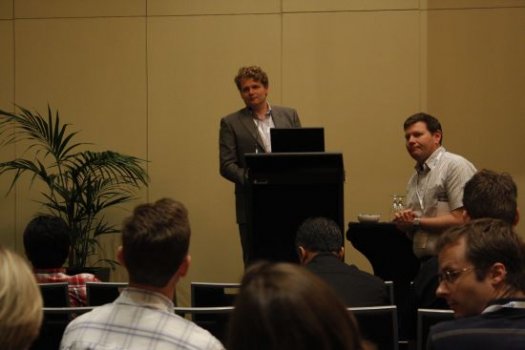 David Thurrowgood: technical examination of paintings
David Thurrowgood: technical examination of paintings
David Thurrowgood from the National Gallery of Victoria talked about the technical examination of paintings, in collaboration with CSIRO and AS staff. He focused on the use of x-ray fluorescence microscopy for obtaining images and chemical information from several significant paintings in the NGV collection. Working at the Australian Synchrotron, David and his colleagues have captured the world’s highest resolution (by several orders of magnitude) elemental maps of the surfaces of historic paintings.
Photo at right shows David Thurrowgood with one of his AS collaborators, Daryl Howard, who chaired this session.
Poster displays and dinner
Thanks to the volume of abstracts received for the User Meeting, a record number of posters were on display. After a day of thought-provoking presentations, delegates enjoyed viewing posters while sampling canapés and refreshing beverages and listening to the Pete Mitchell Jazz Trio. The official User Meeting dinner hosted at the same venue enabled participants to continue discussing their research interests or simply get to know each other better, and featured an animated talk on accelerator science by Michael Hart from the AS Scientific Advisory Committee.



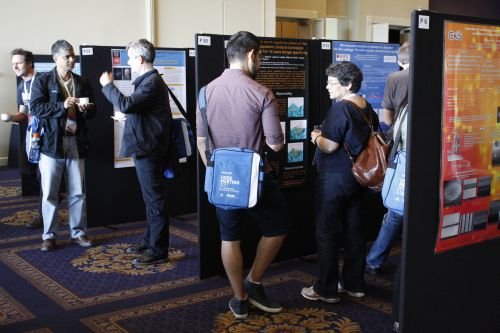
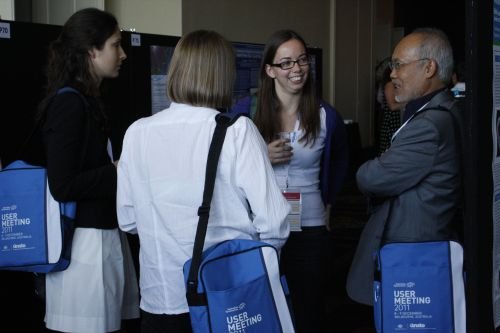
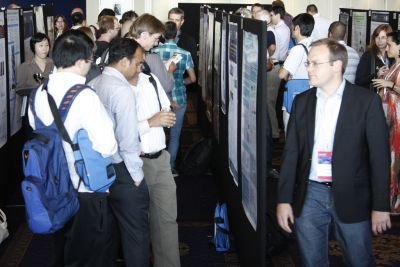

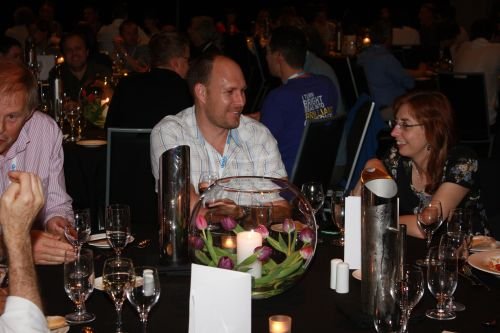
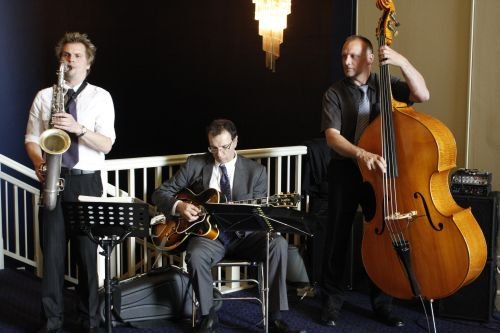
 Jeff Tallon: synchrotrons and superconductivity
Jeff Tallon: synchrotrons and superconductivity
The second day of the User Meeting began with a plenary presentation by Jeff Tallon from Industrial Research Limited in New Zealand. Jeff reminded his audience that 2011 was the centennial of the discovery of superconductivity and also a quarter of a century since the discovery of high-temperature superconductors (high-Tc or HTS). Despite remaining a puzzle to this day, HTS materials are nonetheless being applied in many areas, such as health, transport, energy, mining and minerals processing, telecommunications, information technology and the research sector. Jeff described how HTS are used in synchrotron magnets and how synchrotrons are playing a central role in unravelling the puzzling physics of these mysterious materials. He noted some recent HTS developments that affect synchrotron technologies, including products from his group’s spin-out company HTS-110 Ltd, and highlighted some of the insights that synchrotron science has brought to HTS physics in his own research, including ARPES, infrared ellipsometry, XRD, XAFS and XANES. Click here to see separate article.
Thesis Medal 2011: Kaye Morgan and Corey Putkunz
AS Director Keith Nugent then presented the 2011 Australian Synchrotron Thesis Medal, which was awarded jointly to Kaye Morgan (Monash University) and Corey Putkunz (Melbourne University). As Kaye was unable to attend the meeting due to a prior commitment at a Japanese synchrotron, co-supervisor David Paganin from Monash University accepted the award on her behalf. Corey Putkunz, who undertook his PhD at La Trobe University, gave a presentation about his research into advanced methods of coherent diffractive imaging. His thesis was entitled “New methods in Fresnel coherent diffractive imaging”. 2011 Click here to see separate article.
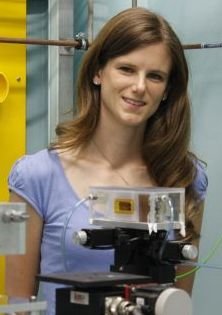
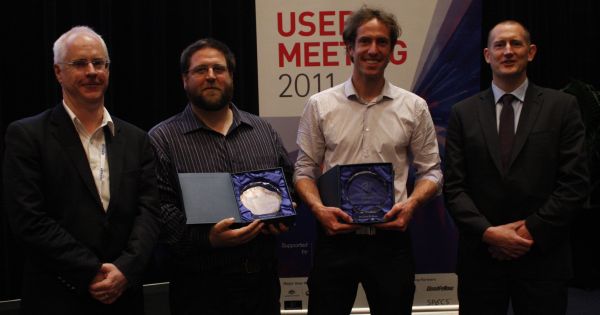
Left-hand photo: Kaye Morgan at the AS. Right-hand photo (L-R): AS Director Keith Nugent, David Paganin (accepting the award on behalf of Kaye Morgan), Corey Putkunz and Andrew Peele (AS Head of Science and Corey’s PhD supervisor).
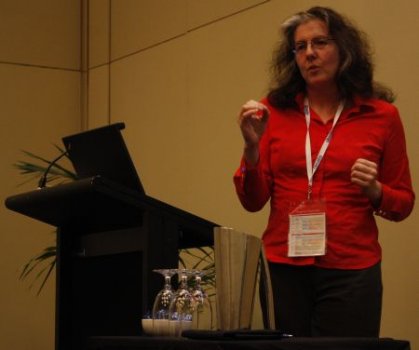 Sherry Mayo: proposed micro-CT beamline
Sherry Mayo: proposed micro-CT beamline
Sherry Mayo from CSIRO (right) talked about the proposal for a micro-CT beamline at the Australian Synchrotron. This beamline would combine multilayer mirror optics with new high-speed x-ray cameras to bring the 4th dimension of time to three-dimensional imaging. It would support imaging and micro-tomography in broadband monochromatic and pink-beam modes with a strong focus on high throughput and high-speed applications. The beamline would draw on existing expertise and infrastructure in phase-contrast imaging and high-speed computing.
 Andrea di Cicco: condensed matter under extreme conditions
Andrea di Cicco: condensed matter under extreme conditions
The final plenary speaker of the 2011 User Meeting was Prof Andrea di Cicco (left) from the FERMI@Elettra free electron laser facility in Trieste, Italy. Andrea gave attendees an insight into the present status of the TIMEX end-station at this facility. TIMEX is devoted to performing experiments on condensed matter under extreme conditions. He discussed the results of the first pilot experiments and end-station tests.
Open forum
In the concluding session of the User Meeting, an open forum with synchrotron scientists, the User Advisory Committee and AS senior management gave participants an opportunity to discuss development issues and challenges at the Australian Synchrotron. The session highlighted the cohesiveness of the Australian Synchrotron research community.
Feedback
Feedback from meeting attendees shows that participants thought the 2011 Australian Synchrotron User Meeting was a resounding success overall. It provided delegates with information, ideas, techniques and updates on the capabilities and future potential of the facility, and a platform for developing and strengthening partnerships and collaborations.
Seventy percent of survey respondents were AS users, and more than 50 percent of respondents were attending an Australian Synchrotron User Meeting for the first time.
Ninety-five percent of respondents rated the 2011 User Meeting as ‘good’ or ‘excellent’, offering comments such as “the conference informed me of the current research and abilities of AS and was run in an organised and enjoyable manner”.
Many thanks to the UAC and External Relations teams for a job well done.
Thank you to all participants for your support and we look forward to welcoming you again in 2012!

"Hello, is that the user support desk? We were just about to storm the enchanted castle with a war dwarf, an elf and a fifth level paladin when the whole damn system crashed... ” (Caption by David Cookson)
